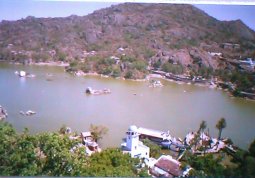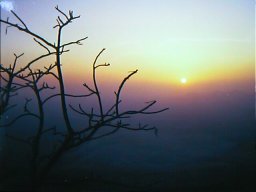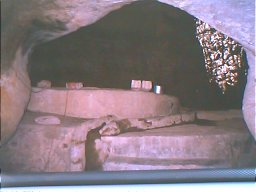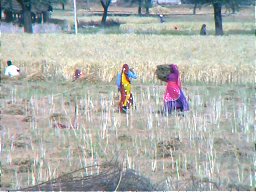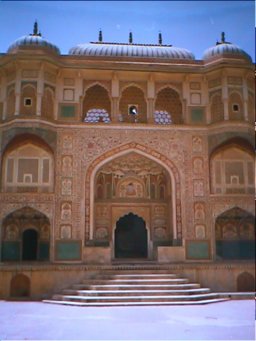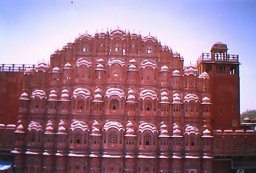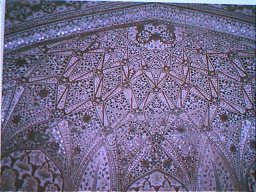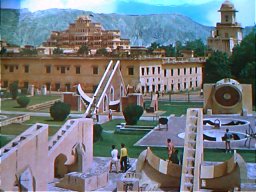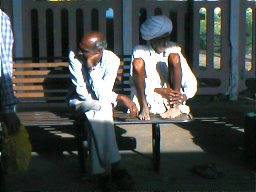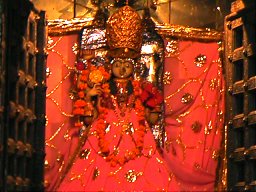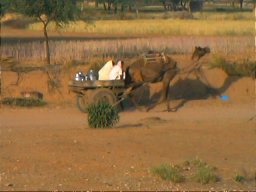|
All images and text are copyright protected. Contact
|
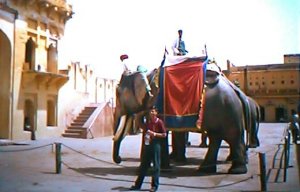 Rajasthan Early in May, Sanjay and I leave Udaipur for Mt Abu, the beginning of our journey to India's northwest. Mt Abu, the only hill station in Rajasthan, is higher and slightly cooler than Udaipur which is baking in the summer heat. Many Gujaratis are also trying to escape the heat by going north; we would see them, like migratory birds, as far north as Himachal Pradesh. The six-hour bus ride to Mt Abu takes us through the green Aravalli Hills where the fresh breeze sustains me. We find a small hotel near Nakki Lake, away from the Polo Grounds and the bright festive streets with holidaymakers, ice cream shops, horse rides and boat rentals. Although Nakki Lake is as holy as the Ganges, no one is bathing and the paddleboats are all ashore as the government looks for a new franchise owner.
We eat ice cream and thallis (a plate of rice with various curries) and walk to Sunset Point, crowded with families and sightseers. Rajasthani men in traditional red turban, white dhoti and kurti, pushing miniature trolleys of tourists up the hill, compete with the horse ride wallahs.
The train to Jaipur, the capital of Rajasthan, passes through the cool Aravalli Hills but once we reach the flat lands the heat swiftly builds to a searing 48o Celsius. In the dry desert heat, no condensation forms on the outside of cold bottled water which quickly heats up to ambient temperature. At the stations, passengers run to fill bottles from the drinking taps. I find it odd that Sanjay seems completely unaffected by the debilitating heat; not even a sweat. He finds it odd that I get cranky when I don't have time alone every day. He is also incapable of eating at street stalls like I do. "Only beggars eat like that," he says. Outside, women in bright saris carry wheat or sit in the meager shade of a shrub. Coming into Jaipur, the balmy, sticky night is a blessing.
In the Pink City we walk among huge astronomical instruments of marble and bronze – so fantastic that they look like works of art. Built by the same Maharaja Sawai Jai Singh II, Jantar Mantar is the largest stone observatory in the world and was the most accurate at the time. An avid scientist, he built four other observatories in Delhi, Varanasi, Ujjain and Mathura. Even with a ceiling fan, the nights are so hot that I cannot sleep. Sanjay, seeing me lying on the bare marble floor under the fan, kindly sprinkles water on my bed to cool it down. "Shall we go to Jaisalmer?" I ask. "I want to see the Thar desert." "Jaisalmer is even hotter," says Sanjay. "Come, you want to see a village?"
A Discman, a digital camera and a digital watch all excite them more than their television which they don't often look at. In the yard are two water buffalo which provide milk and dung for fuel. Their aircooler (a metal box with water dripping down three sides and a fan that blows water droplets) cools the room somewhat and allows me to sleep. In the evening we go to the village fair. There are stalls with clothes and household articles but we stick to the fun and food stalls and the Ferris wheel ride. It reminds me of the fairs I went to as a child; the excitement of bright lights and fairground music and the dread of getting lost in a crowd. At dawn, Sanjay's uncle takes me on his motorbike through the cool, sleepy countryside to the Kailadevi Temple near Karauli city. It is the first time that I see Hindus prostrating themselves full length on the ground around the temple and we too do pradakshina, circumambulating the temple three times in a clockwise direction. Both rituals I had believed to be Tibetan Buddhist but Sanjay's uncle says it is a Hindu tradition. There are, however, other similarities between Hinduism and Tibetan Buddhism especially in Nepal where both religions have been fused into one.
He leaves me to escape the heat of the day in the Karauli home of his friend, Ramniwas, where his two sons and neighbours entertain me. Ashwani, 12, speaks excellent English and invites me to his nearby home to meet his parents. They are Brahmin and lead a very austere life. The father shows me his shrine and talks about their customs. "If," I ask Ashwani, "you were to become a Sikh, would your family allow you to live here?"
Raceandhistory.com | Howcomyoucom.com | Trinicenter.com | TriniView.com Another 100% non-profit Website serving poorly represented communities. Copyright & Disclaimer. - - Privacy Policy --Designed & maintained by S.E.L.F. © 2002 TriniView.com |

